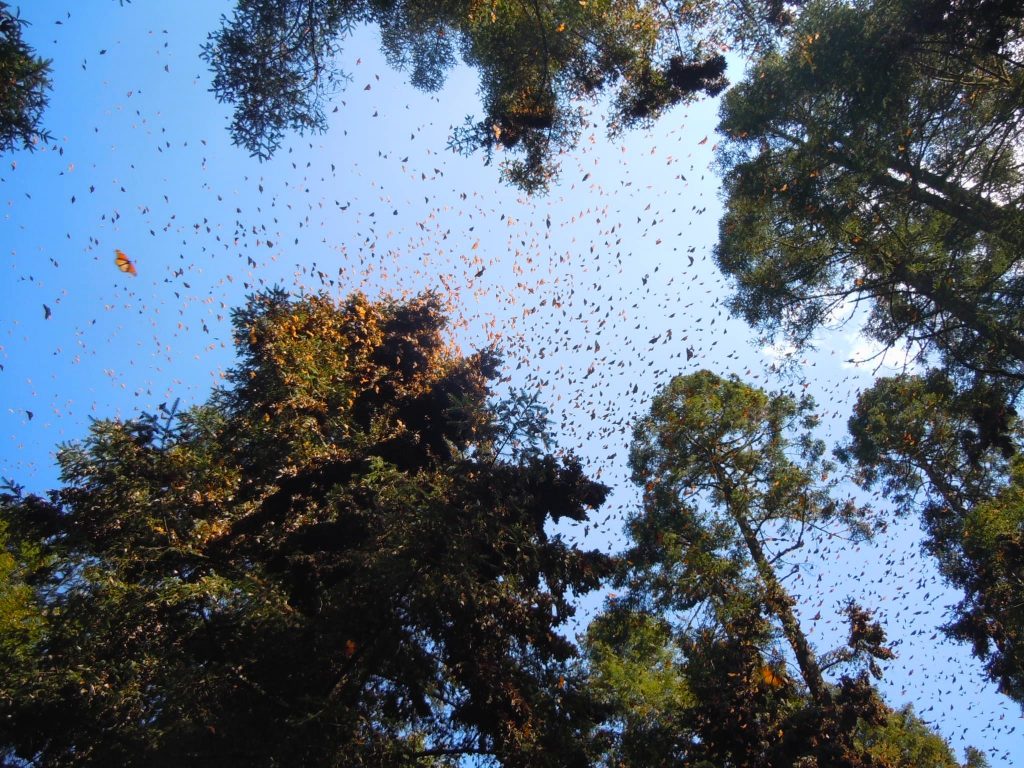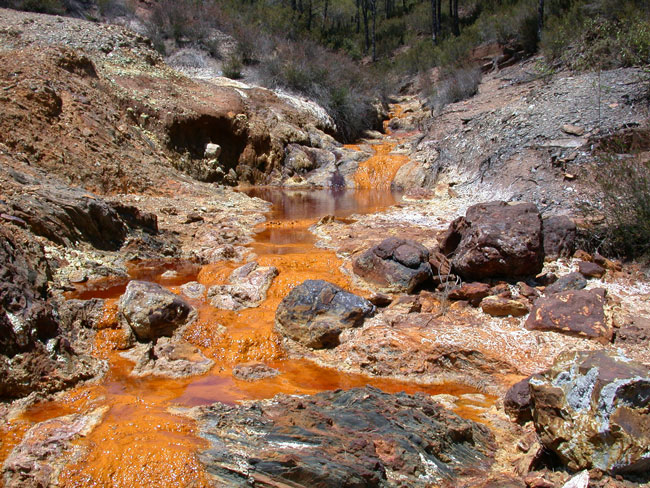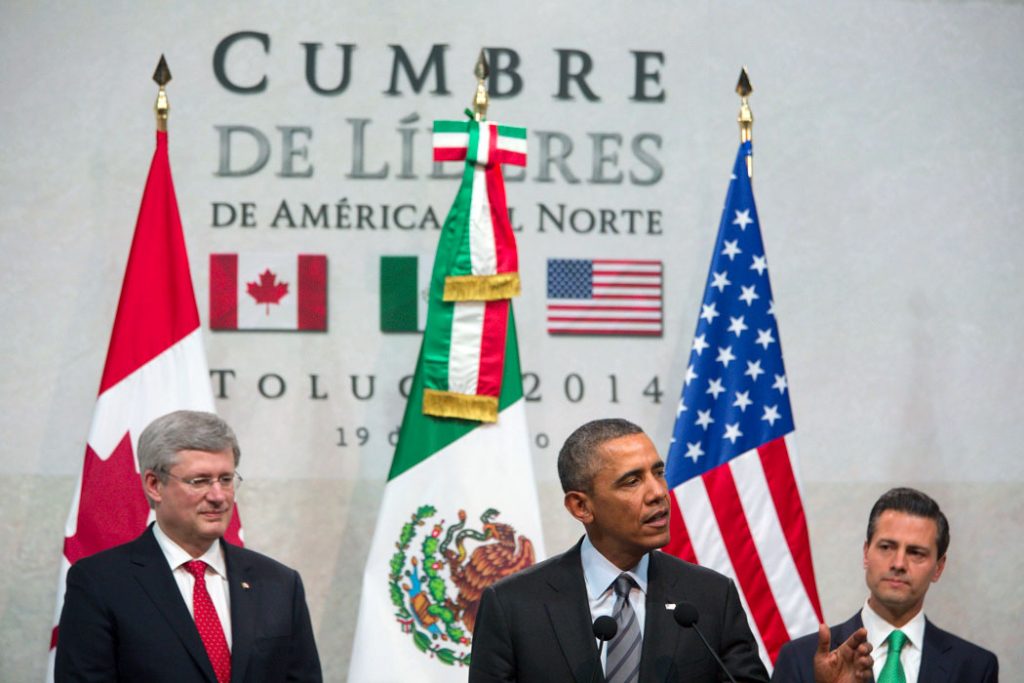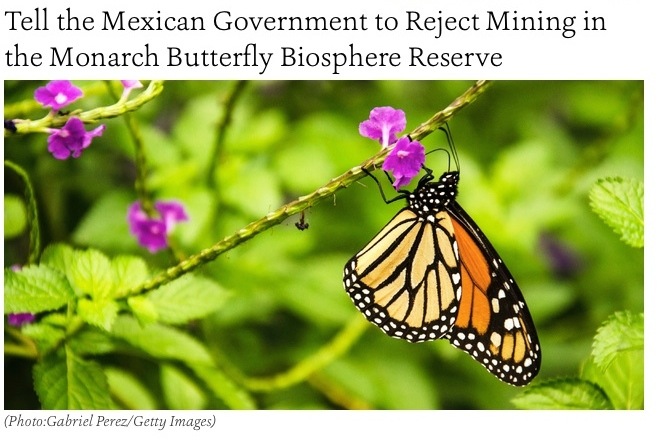While the U.S. channels millions of dollars into research, citizen science outreach, and public education on the importance of the Monarch butterfly migration, Mexico is considering the approval of permits that would allow its largest mining company with the country’s worst environmental record to reopen a copper mine in the heart of the Monarchs’ ancestral roosting sites.

What will happen to the roosting sites if copper mining returns to Angangueo? Photo by Monika Maeckle
Grupo Mexico, which trades on the Mexican Stock Exchange under the ticker symbol GMEXICOB and has a market cap of $317 billion, claims that a mine it operated until 1992 in Angangueo, Michoacán, technically never closed, and thus should be allowed to reopen, despite protections put in place for the Monarch Butterfly Biosphere Reserve. The reserve was inscribed as a World Heritage site by UNESCO in 2008.
Grupo Mexico touts itself on the company’s website as a “leader in low-cost production” and has a deserved reputation for lax ecological controls. The company was responsible for the worst mining accident in Mexican history.
In August of 2014, the holding company’s Buenavista copper mine in Sonora released 10 million gallons of copper sulfate acid and other heavy metals into the Sonora and Bacanuchi rivers, contaminating the water supply of 24,000 people along the U.S. border with Arizona. Mexico’s Minister of Environment Juan José Guerra called the incident the “worst natural disaster provoked by the mining industry in the modern history of Mexico.” Grupo Mexico attributed the accident to heavy rains.

Grupo Mexico touts its low cost leadership on its website. Graphic via gmexico.com the worst natural disaster provoked by the mining industry in the modern history of Mexico,” said Grupo Mexico blamed the accident on heavy rains.
The accident was so severe that for the first time in Mexican history, PROFEPA, the country’s equivalent of the Environmental Protection Agency, was forced by community outrage to file a legal complaint against the mining company, holding it financially responsible for the clean-up. Grupo Mexico was forced to create a $150 million trust to address the environmental impacts.
A September 2014 dispatch in El Financiero, Mexico’s leading business and financial news daily, cited a report from a special Mexican Congressional investigation into the Buenavista incident. The conclusion: “Grupo Mexico and its affiliate Buenavista del Cobre mine, far from being a socially responsible enterprise respectful of the environment and in solidarity with the local population, have put at risk human life, the environment and the economic development of the region.”
The above catastrophe wasn’t the only time Grupo Mexico unleashed a mining disaster. Back in 2006, an explosion at the Pasta de Conchos mine in Coahuila killed 65 miners. After striking 14 times because of methane leaks and generally unsafe working conditions, the unionized miners were blown to bits in the blast. In addition to the significant loss of life, serious environmental impacts resulted–air and water pollution, soil contamination, erosion, deforestation and more.
This incident, along with the Buenavista disaster and a corporate history of union busting and low-cost mining, have earned Grupo Mexico a reputation as “one of the country’s most irresponsible mining companies,” according to the Transborder Project in Washington, DC.

Will copper mining come to the Monarch butterfly roosting sites in Angangueo, Mexico? Photo by Carol Stoker, NASA, Wikipedia
The turn of events is literally unbelievable given that a little over two years ago Mexican President Enrique Peña Nieto stood with President Obama and Canadian Prime Minister Stephen Harper and pledged to support the preservation of the Monarch butterfly migration.
In February 2014, shortly after scientists announced the Monarch butterfly population had dropped precipitously to historic lows of about 35 million butterflies from highs of 450 million in years’ past, the three heads of state gathered in Toluca, Mexico, just 75 miles from the roosting sites. With great fanfare, “los trés amigos” committed to do what they could to save the Monarch butterfly migration.
“We have also agreed to work on the preservation of the Monarch butterfly as an emblematic species of North America which unites our three countries,” President Enrique Peńa Nieto said at the end of the summit. The leaders agreed to form a task force to study the situation and “ensure the conservation of the Monarch butterfly.”

President Barack Obama President Enrique Pena Nieto and Prime Minister Stephen Harper pledged to help save the Monarch butterfly migration back in 2014. (Official White House Photo by Amanda Lucidon)
So, how does allowing a company with one of the worst environmental records in Mexican history to reopen a copper mine in the heart of the Monarch Butterfly Biopreserve move us toward that goal?
“In México, in governmental affairs linked to big companies, corruption has no limits,” said one Mexican scientist, who, like several Mexican residents interviewed, asked to remain nameless for fear of reprisals. Another source said he would like to speak out, but wouldn’t because he had neither the “stature nor protection” to do so.
The move by Grupo Mexico to reopen the mine has been underway for years, but came into U.S. focus most recently when Pulitzer prize-winning journalist Dan Fagin addressed the subject in a thoughtful April 29 New York Times opinion piece headlined “A Mine vs. a Million Monarchs.” The article lays out the complex issues facing the community of Angangueo as they struggle for economic stability building a nascent ecotourism economy in the middle of the Mexican mountains.
Fagin’s piece was shared profusely on the DPLEX list, an email listserv of about 800 butterfly aficionados, from academics to novices, as well as other online outlets. The exposure provoked a petition by the Endangered Species Coalition, Tell the Mexican Government to Reject Mining in the Monarch Butterfly Biosphere Reserve.
“It’s difficult to say what’s going to happen,” said Dr. Chip Taylor, founder of Monarch Watch, the citizen scientist program that tags thousands of migrating Monarch butterflies each fall, by phone this week. He added that he’d heard that many in the Mexican government oppose the mine.
“There are lots of declarations by people who say that they’re not going to let certain things happen– and then they do happen.” Taylor encouraged a united front in opposition to the reopening of the mine.
Grupo Mexico did not respond to requests for comment on this story.
Sign the petition here.
Related posts:
- Scientists try to assess Monarch butterfly mortality after Mexican freeze
- At least 1.5 million Monarch butterflies perish in freak Mexican snowstorm
- Good news! Monarch butterfly population triples
- Mighty Monarch butterflies brave south winds, Hurricane Patricia to arrive in Mexico
- Q & A Elizabeth Howard of Journey North talks tech, citizen science, butterfly releases
- Q & A: Catalina Trail, founder of the Monarch butterfly roosting sites
- 2015 a Banner Year? Monarch butterfly migration heading our way
- Q & A: Dr. Lincoln Brower on Endangered Species, Ethics, Milkweed and Monarchs
- How to tag a Monarch butterfly in Six Easy Steps
- Endangered Species Act Wrong Tool for the Job of Monarch Butterfly Conservation?
- Monarch Butterfly Inches Toward “Threatened” Status Under Endangered Species Act
Like what you’re reading? Follow butterfly and native plant news at the Texas Butterfly Ranch. Sign up for email delivery, like us on Facebook, or follow us on Twitter, @monik


I was told to disinfect my butterfly cage with 10% bleach…to destroy moth eggs. The moth is entering the freshly laid egg and the butterfly never fully develops.
Thank you Monika for writing such an articulate article regarding the many concerns about Grupo Mexico and mining at the Monarch Butterfly Biosphere Reserve. I’m sure your blog will garner many signatures on the petition and as subscribers share your article with others, there will be more & more signatures as a result of your efforts. Thank you for increasing awareness and gaining support for the petition.
The mine in Angangueo is underground and located about 5 miles away and 2,000 feet below the altitude of the nearest monarch overwintering site (El Rosario). Thus it is difficult to imagine how any monarchs or cluster trees could be harmed by the mine.
The monarchs do not come down to Angangueo to drink water. Angangueo is surrounded by hillsides containing crop fields http://www.imagegainer.com/images/PaulCherubini/ang.jpg If depletion of ground and spring water was an issue then the crop farmers in the area should be opposing the mine. But they are not to my knowledge.
Update on petition: New goal is 30,000 signatures by November 1st. The petition reached 10,000 in late July. On August 26, there were11,099 signatures. Please sign & promote the petition to reject mining in the biosphere reserve.
Perhaps you should come to our Festival October 21 – 22 and solicit signatures! Here’s the details: https://www.facebook.com/events/297621927269160/
I’m sure you would find a sympathetic crowd. –Monika